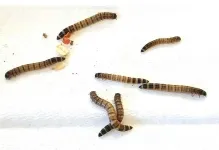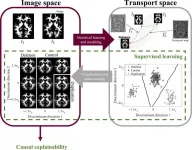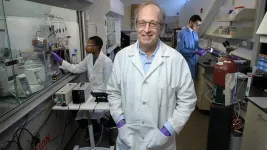(Press-News.org) New Haven, Conn. — More than two decades ago, a research team in the lab of David Hafler, a Yale researcher who at the time was at Harvard, discovered a type of T cell in humans that suppresses the immune system; they later found that these so-called regulatory T cells, when defective, are an underlying cause of autoimmune disease, specifically multiple sclerosis (MS). For many years, however, the mechanism behind this dysfunction has remained unclear.
In a new Yale-led study, a team of researchers finds that this loss of immune regulation is triggered by an increase in PRDM1-S, a protein involved in immune function, triggering a dynamic interaction of multiple genetic and environmental factors, including high salt uptake.
The findings, published in the journal Science Translational Medicine, also reveal a new target for a universal treatment for human autoimmune disease.
The research was led by Tomokazu Sumida, an assistant professor at Yale School of Medicine (YSM), and Hafler, the William S. and Lois Stiles Edgerly Professor of Neurology and professor of immunobiology at Yale.
“These experiments reveal a key underlying mechanism for the loss of immune regulation in MS and likely other autoimmune diseases,” said Hafler, who is also chair of Yale’s Department of Neurology. “They also add mechanistic insight into how Treg [regulatory T cells] dysfunction occurs in human autoimmune diseases.”
Autoimmune diseases, among the most common disorders of young adults, are known to be affected by genetic and environmental factors, including vitamin D deficiency and fatty acids. In an earlier study, Sumida and Hafler found that high levels of salt also contribute to the development of multiple sclerosis, an autoimmune disease of the central nervous system. Specifically, they observed that high salt induces inflammation in a type of immune cell known as CD4 T cells, while also causing a loss of regulatory T cell function. This, they found, is mediated by a salt-sensitive kinase, or enzyme critical for cell signaling, known as SGK-1.
For the new study, researchers used RNA sequencing to compare gene expression in patients with MS with expression in healthy individuals. In patients with MS, the researchers identified upregulation, or increased expression, of a gene called PRDM1-S (primate-specific transcription factor), also known as BLIMP-1, which is involved in regulating immune function.
Surprisingly, PRDM1-S induced increased expression of the salt-sensitive SGK-1 enzyme, leading to disruption of regulatory T cells, the researchers found. Moreover, they found similar overexpression of PRDM1-S in other autoimmune diseases, suggesting that it may be a common feature of regulatory T cell dysfunction.
“Based on these insights, we are now developing drugs that can target and decrease expression of PRDM1-S in regulatory T cells,” Sumida said. “And we have initiated collaborations with other Yale researchers using novel computational methods to increase the function of regulatory T cells to develop new approaches that will work across human autoimmune diseases.”
The study was done with Bradley Bernstein and Manolis Kellis, longtime collaborators of Hafler from the Broad Institute of MIT and Harvard, and several other research institutions.
Other authors from the Yale lab include neurologist Matthew R. Lincoln, and post-graduate research assistants Alice Yi, Helen Stillwell, and Greta Leissa.
END
Study reveals molecular mechanism behind MS and other autoimmune diseases
2024-08-28
ELSE PRESS RELEASES FROM THIS DATE:
To build a thriving electric vehicle market, prioritize equity and justice
2024-08-28
When it comes to purchasing and using electric vehicles (EVs), housing- and income-related factors significantly shape perceptions and preferences among potential buyers, finds a new study in Energy and Climate Change. This research, a collaboration between the Boston University Institute for Global Sustainability (IGS) and the U.S. Department of Energy’s National Renewable Energy Laboratory (NREL), is among the first to examine both EV adoption and charging infrastructure through an equity lens coupled with state-of-the-art original survey data.
Understanding the barriers to widespread EV adoption ...
Large language models can help detect social media bots — but can also make the problem worse
2024-08-28
An external study of Twitter in 2022 estimated that between a third and two thirds of accounts on the social media site were bots. And many of these automatons flooding social media are dispatched to sow political polarization, hate, misinformation, propaganda and scams. The ability to sift them out of the online crowds is vital for a safer, more humane (or at least more human) internet.
But the recent proliferation of large language models (known as "LLMs" for short), such as OpenAI’s ChatGPT and Meta’s Llama, ...
How beetle juice led to the discovery of a virus and solved the mystery of a superworm die-off
2024-08-28
Rutgers University-New Brunswick scientists have discovered a virus that caused a nationwide die-off of superworms, a common food for birds, reptiles, other pets and, more and more so, even for humans as an alternative protein source. In doing so, they pioneered a different way to search for and identify emerging viruses and pathogens in humans, plants and animals.
Using chopped up beetle carcasses forming a slurry and an electron microscope cooled by liquid nitrogen, the scientists reported today in Cell that they have discovered what they have titled Zophobas morio black wasting virus. The name is derived from ...
Leading computational scientist & oncology researcher Elana Fertig appointed new Director of the Institute for Genome Sciences
2024-08-28
University of Maryland School of Medicine (UMSOM) Dean Mark T. Gladwin, MD, announced today the appointment of Elana J. Fertig, PhD, FAIMBE, as the new Director of the School’s Institute for Genome Sciences (IGS). She is internationally-recognized for her work in integrating spatial multi-omics technologies with mathematical models to develop a new predictive medicine paradigm in cancer. Spatial technologies allow researchers to learn about any cell type inside of natural tissue, including gene activity ...
UVA research cracks the autism code, making the neurodivergent brain visible
2024-08-28
A multi-university research team co-led by University of Virginia engineering professor Gustavo K. Rohde has developed a system that can spot genetic markers of autism in brain images with 89 to 95% accuracy.
Their findings suggest doctors may one day see, classify and treat autism and related neurological conditions with this method, without having to rely on, or wait for, behavioral cues. And that means this truly personalized medicine could result in earlier interventions.
“Autism is traditionally diagnosed behaviorally but has a strong genetic basis. A genetics-first approach could ...
Marine engineering group to award ORNL researchers for innovative welding software
2024-08-28
Zhili Feng, a distinguished R&D staff member, and Jian Chen, a senior R&D staff member, in Materials Science and Technology Division at the Department of Energy’s Oak Ridge National Laboratory, will receive the Elmer L. Hann Award at the Society of Naval Architects and Maritime Engineers, or SNAME, Convention on Oct. 15 in Norfolk, Virginia. SNAME plays a crucial role in promoting excellence in marine engineering and naval architecture, supporting professionals through education, research and collaboration.
The award is presented to authors of the best paper on ship production delivered at a SNAME event. In September 2023, Feng and Chen presented “Develop ...
UBC engineers develop all-in-one solution to catch and destroy ‘forever chemicals’
2024-08-28
Chemical engineers at the University of British Columbia have developed a new treatment that traps and treats PFAS substances—widely known as “forever chemicals”—in a single, integrated system.
Per- and polyfluoroalkyl substances (PFAS) are widely used in manufacturing consumer goods like waterproof clothing due to their resistance to heat, water and stains. However, they are also pollutants, often ending up in surface and groundwater worldwide, where they have been linked to cancer, liver damage and ...
Purdue researchers take inspiration from viruses to improve delivery of nucleic acid-based therapies to cancer cells
2024-08-28
WEST LAFAYETTE, Ind. — A researcher in Purdue University’s College of Science is developing a patent-pending platform technology that mimics the dual-layer structure of viruses to deliver nucleic acid (NA)-based therapies to targeted cancer cells.
David Thompson leads a team developing the carrier system called LENN. He is a professor in the James Tarpo Jr. and Margaret Tarpo Department of Chemistry and on the faculty of the Purdue Institute for Cancer Research and the Purdue ...
New USC research reveals untapped potential for mobilizing voters of color in battleground states
2024-08-28
With swing states playing a pivotal role in the 2024 presidential election, new reports from the Center for Inclusive Democracy (CID) at the USC Sol Price School of Public Policy have found significant voter turnout disparities between white, non-Latino voters and voters of color in all nine battleground states.
The reports highlight the persistent “voter representation gap,” where voters of color remain underrepresented at the polls, despite substantial population growth. If narrowed by November, the research concludes, this gap could significantly influence election results, particularly in swing states that had particularly close ...
The Public Health Career Explorer launches, matching health department job openings with career interests and preparation
2024-08-28
August 28, 2024-- A new, easy-to-use, evidence-based career assessment, the Public Health Career Explorer, has just launched to help job-seekers who are interested specifically in public health careers.
The Public Health Career Explorer career assessment tool, three years in the making, was developed at Columbia University Mailman School of Public Health. Using the well-researched O*Net MyNextMove assessment, Columbia Mailman School’s Heather Krasna, PhD, EdM, MS, associate dean of career and professional development painstakingly matched the Holland Codes (career interest codes) for each of the specific ...






